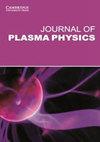Direct stellarator coil design using global optimization: application to a comprehensive exploration of quasi-axisymmetric devices
IF 2.5
3区 物理与天体物理
Q2 PHYSICS, FLUIDS & PLASMAS
引用次数: 0
Abstract
Many stellarator coil design problems are plagued by multiple minima, where the locally optimal coil sets can sometimes vary substantially in performance. As a result, solving a coil design problem a single time with a local optimization algorithm is usually insufficient and better optima likely do exist. To address this problem, we propose a global optimization algorithm for the design of stellarator coils and outline how to apply box constraints to the physical positions of the coils. The algorithm has a global exploration phase that searches for interesting regions of design space and is followed by three local optimization algorithms that search in these interesting regions (a ‘global-to-local’ approach). The first local algorithm (phase I), following the globalization phase, is based on near-axis expansions and finds stellarator coils that optimize for quasisymmetry in the neighbourhood of a magnetic axis. The second local algorithm (phase II) takes these coil sets and optimizes them for nested flux surfaces and quasisymmetry on a toroidal volume. The final local algorithm (phase III) polishes these configurations for an accurate approximation of quasisymmetry. Using our global algorithm, we study the trade-off between coil length, aspect ratio, rotational transform and quality of quasi-axisymmetry. The database of stellarators, which comprises approximately 200 000 coil sets, is available online and is called QUASR, for ‘quasi-symmetric stellarator repository’.利用全局优化直接设计恒星器线圈:应用于准轴对称器件的全面探索
许多恒星仪线圈设计问题都存在多重最小值,局部最优线圈组的性能有时会有很大差异。因此,用局部优化算法一次性解决线圈设计问题通常是不够的,更好的最佳值很可能确实存在。为了解决这个问题,我们提出了一种用于设计恒星器线圈的全局优化算法,并概述了如何对线圈的物理位置应用盒式约束。该算法有一个全局探索阶段,用于搜索设计空间中的有趣区域,随后有三个局部优化算法在这些有趣区域中进行搜索(一种 "全局到局部 "的方法)。第一个局部算法(第一阶段)紧随全局化阶段之后,以近轴扩展为基础,寻找在磁轴附近优化准对称性的恒星线圈。第二个局部算法(第二阶段)采用这些线圈组,并针对嵌套磁通量面和环形体积上的准对称性进行优化。最后一种局部算法(第三阶段)对这些配置进行优化,以精确逼近准对称性。利用我们的全局算法,我们研究了线圈长度、长宽比、旋转变换和准轴对称质量之间的权衡。恒星器数据库包括约 200 000 个线圈组,可在线获取,名为 QUASR,意为 "准对称恒星器存储库"。
本文章由计算机程序翻译,如有差异,请以英文原文为准。
求助全文
约1分钟内获得全文
求助全文
来源期刊

Journal of Plasma Physics
物理-物理:流体与等离子体
CiteScore
3.50
自引率
16.00%
发文量
106
审稿时长
6-12 weeks
期刊介绍:
JPP aspires to be the intellectual home of those who think of plasma physics as a fundamental discipline. The journal focuses on publishing research on laboratory plasmas (including magnetically confined and inertial fusion plasmas), space physics and plasma astrophysics that takes advantage of the rapid ongoing progress in instrumentation and computing to advance fundamental understanding of multiscale plasma physics. The Journal welcomes submissions of analytical, numerical, observational and experimental work: both original research and tutorial- or review-style papers, as well as proposals for its Lecture Notes series.
 求助内容:
求助内容: 应助结果提醒方式:
应助结果提醒方式:


